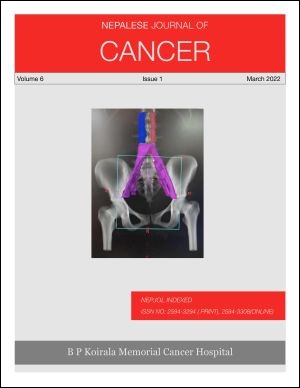Use of Indocyanine green (ICG) angiography to minimize anastomotic leak in the neck after esophagectomy
DOI:
https://doi.org/10.3126/njc.v6i1.44212Keywords:
Indocyanine green, esophagectomy, anastomotic leak.Abstract
Introduction: Anastomotic leak after esophagectomy for cancer of mid and lower esophagus and gastroesophageal junction (GEJ) still remains a major challenge. Poor perfusion of the gastric conduit remains the main factor for leak. Intra-operative assessment of the gastric conduit with indocyanine green (ICG) angiography helps to select a properly perfused site for anastomosis, thus minimizing the leak.
Methods: Patients undergoing surgery for cancer of esophagus and GEJ either through open or minimally approach were taken up for this study. Stomach was used for reconstruction and anastomosis was made in neck. A 0.1ml of test dose of ICG was given intra-dermally to look for any reaction. After that a dose of 5-10 milligrams was injected intravenously. Perfusion was assessed with infrared light using laparoscopic telescope. The timing of perfusion of the conduit was recorded. Well perfused segment was used for gastroesophageal anastomosis. Different parameters including leak were compared with non-ICG group.
Results: We studied 474 patients. Among these patients 67 were in ICG group and 407 were in non-ICG group. Mean age, mean weight loss and co-morbidities were similar in both groups. 72% of patients in ICG group and 50% of patient in non-ICG groups had multimodality treatment. 67% of patients in ICG group and 46% of patients in non-ICG group underwent minimally invasive surgery (p<0.001). Post-operative complications like pneumonia, recurrent laryngeal nerve palsy and surgical site infection were similar in both groups. Post-operative mortality was seen in 1.5% and 3.7% in ICG group and non-ICG group respectively (p=0.4). Overall leak in ICG group was 9% and 16.5% in non-ICG group (p=0.06). In ICG group with the perfusion time of more than 60 seconds, the leak rate was only 3.5% in comparison to 16.5% in non ICG group (p=0.009).
Conclusion: ICG angiography provides an objective assessment about the perfusion of gastric conduit during the time of anastomosis. Anastomosis at area of gastric conduit with perfusion time less than 60 seconds, minimizes leak rate in neck.
Downloads
Downloads
Published
How to Cite
Issue
Section
License
Copyright (c) 2022 Nepalese Journal of Cancer

This work is licensed under a Creative Commons Attribution 4.0 International License.
This license lets others distribute, remix, tweak, and build upon your work, even commercially, as long as NJC and the authors are acknowledged.
Submission of the manuscript means that the authors agree to assign exclusive copyright to NJC. The aim of NJC is to increase the visibility and ease of use of open access scientific and scholarly articles thereby promoting their increased usage and impact.




